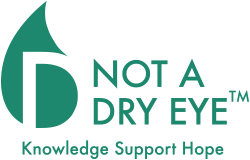If you’re a patient wondering why your Dry Eye symptoms aren’t getting better, you might ask yourself these three questions.
1. Are you describing your symptoms accurately?

There’s not much a doctor can do for you if all you say is your left eye doesn’t feel good. Your doctor will have to ask more questions before she knows what’s really going on. But if you’re specific from the start about what you’re feeling, e.g.: my left eye burns all over and I see bubbles in the tear film, your doctor might still have to ask a few questions (and even examine you), but at least you’ll be one step closer to an accurate diagnosis.
It helps the doctor if you’re clear, concise, and descriptive. Take a few moments, focus on what you’re eyes are feeling, and find the words that accurately describe your symptoms.
Plus, be sure to tell your doctor right away if you experience a new symptom. Let her know if treatment isn’t giving you the expected relief. You doctor can’t help you if she doesn’t know what’s going on.
2. Is your doctor really listening to you?
As long as you’re very clear about your symptoms and reporting them in a timely manner, your doctor should listen and not be dismissive. Your doctor probably knows something you don’t. But a doctor who doesn’t really listen to what you’re saying, or a doctor who’s rude or dismissive, just might not be the right one for you.
Sometimes it’s not just doctors who don’t listen. Sometimes it’s the organizations that represents doctors. We came across this last year when we reached out to the Tear Film and Ocular Surface Society (TFOS). As a patient organization we had hoped to provide the patient perspective to the upcoming Dry Eye Workshop II. Unfortunately, the organization’s leadership declined our participation. So instead we wrote a letter.
Not A Dry Eye Foundation’s Letter to DEWS II
We sent the letter to the over 100 DEWS II participants. None of the participants wrote back. (So much for welcoming patient input). Maybe they’re just not aware of the importance of patient participation in healthcare. Here’s an example. The National Academy of Medicine (NAM), will be holding a meeting on July 17, 2017, in Washington D.C. to improve diagnosis in health care. One break-out group focusing on Patient-Centered Health Care, Education and Policy to Improve Diagnosis, will be asked these questions:
How can patient advocates improve the emphasis on patient-centered policies related to diagnosis in clinician practices, hospitals, and within the larger policy arena?
How can patient involvement in the diagnostic process be encouraged at all levels, including in the creation and implementation of policy, in addition to clinician-patient interactions?
Are you/Is your organization considering opportunities to better involve patients and families in promoting and improving patient-centeredness in diagnosis?
These are just a few sample questions, but do you notice the focus on patient input and patient participation?
Needless to say, we’re looking forward to reviewing the DEWS II reports when they come out later this year. We may even write them another letter.
3. Could it be the drops you’re using?
You’ve probably heard the saying, the treatment is worse than the disease. It’s true for eye treatments too.
It’s possible to develop allergies, or sensitivities, to the medicine that’s supposed to make you feel better. Preservatives and other compounds in drops and ointments can cause irritation. So if your symptoms persist, and you’re using a drop or ointment, or any other topical treatment, let your doctor know. Ask if the medicine could be the cause. Your doctor might suggest a different medication or tell you to stop the one you’re using altogether.
There are countless reasons why Dry Eye patients suffer with chronic symptoms or why new symptoms crop up. Asking yourself these three questions can help you embark on your journey to healing faster.
Please note, the Dry Eye blog will be on vacation for the rest of the summer. Be sure to subscribe to our blog to hear from us as soon as we get back.
Reference
Improving Diagnosis in Health Care: Implementation Workshop
Quality Chasm Series
Briefing Book
July 17, 2017
The National Academy of Sciences
Lecture Room
2101 Constitution Avenue NW
Washington D.C. 20418
Send your questions and comments to blogger@notadryeye.org.
Subscribe to our blog to keep up with Not A Dry Eye.
Support Not A Dry Eye Foundation. When you shop at smile.amazon.com, Amazon donates 0.5% of your purchase.

